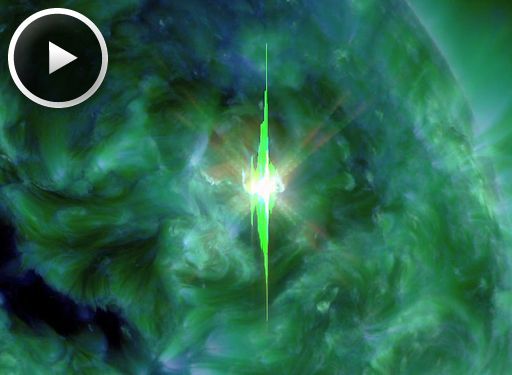
2014 SPACEWEATHER PAGES
JANUARY -
FEBRUARY, MARCH,
APRIL, MAY, JUNE, JULY, AUGUST,
SEPTEMBER, OCTOBER, NOVEMBER,
DECEMBER
Dee Finney's blog
start date July 20, 2011
today's date March 1, 2014
updated daily
page 648
TOPIC: SPACEWEATHER - MARCH 2014
3-31-14
Solar wind
speed: 390.6 km/sec
density: 3.4 protons/cm3

article on the 29th
**
3-30-14
Solar wind
speed: 384.1 km/sec
density: 2.0 protons/cm3
solar flare news same as yesterday
3-29-14
Solar wind
speed: 452.0 km/sec
density: 6.6 protons/cm3
X-FLARE: The magnetic canopy of sunspot AR2017 erupted yesterday, March 29th,
producing an impulsive X1-class solar flare. Ionizing radiation from the flare
produced electrical currents in Earth's upper atmosphere and a ripple in Earth's
magnetic field detected by magnetometers across the dayside of our planet. Read
more about this rare "magnetic crochet" and the possibility of more X-flares
this weekend on today's edition of http://spaceweather.com.
SOLAR FLARE ALERTS: Would you like a call the next time the sun erupts? X-flare
alerts are available from
http://spaceweathertext.com (text) and
http://spaceweatherphone.com
(voice).
9 fireballs reported
3-28-14
Solar wind
speed: 435.5 km/sec
density: 1.5 protons/cm3
A 'TETRAD' OF LUNAR ECLIPSES: A total lunar eclipse on April 15th marks the beginning of a 'tetrad' -- a series of four consecutive lunar eclipses all visible from North America. Get the full story from Science@NASA.
HUBBLE SEES JETS IN MARS COMET: Later this year, Mars is going to have a close encounter with a comet. On Oct. 19, 2014, Comet Siding Spring (C/2013 A1) will buzz the Red Planet about 10 times closer than any known comet has ever flown past Earth. Mars could actually find itself inside the comet's extended atmosphere as the comet passes by only 138,000 km away. Needless to say, NASA is watching carefully. The latest images from the Hubble Space Telescope show jets spewing from the comet's core:
A 'TETRAD' OF LUNAR ECLIPSES: A total lunar eclipse on April 15th marks the beginning of a 'tetrad' -- a series of four consecutive lunar eclipses all visible from North America. Get the full story from Science@NASA. HUBBLE SEES JETS IN MARS COMET: Later this year, Mars is going to have a close encounter with a comet. On Oct. 19, 2014, Comet Siding Spring (C/2013 A1) will buzz the Red Planet about 10 times closer than any known comet has ever flown past Earth. Mars could actually find itself inside the comet's extended atmosphere as the comet passes by only 138,000 km away. Needless to say, NASA is watching carefully. The latest images from the Hubble Space Telescope show jets spewing from the comet's core: The image, captured on March 11th, shows comet Siding Spring at a distance of 353 million miles from Earth. Hubble can't see the icy nucleus because it is hidden inside the comet's glowing dusty atmosphere. Nevertheless, image processing did reveal what appears to be two jets of dust coming off the nucleus in opposite directions. This observation allows astronomers to calculate the direction of the nucleus's pole, and axis of rotation. "This is critical information that we need to determine whether, and to what degree, dust grains in the [atmosphere] of the comet will impact Mars and spacecraft orbiting Mars," says Jian-Yang Li of the Planetary Science Institute in Tucson, Arizona. Indeed, meteoroids from the comet could hit NASA's Mars orbiters and damage them even as the orbiters try to study the comet. The level of risk won't be known for months, but NASA is already evaluating possible precautionary measures. Data from Hubble and other observatories in the months ahead will clarify the dangers. 8 fireballs reported |
3-27-14
Solar wind
speed: 393.0 km/sec
density: 1.0 protons/cm3
QUIET THURSDAY: On the sun today, two sunspots (AR2010 and AR2014) have unstable magnetic fields that harbor energy for significant flares. However, neither one is flaring. Solar activity is low and likely to remain so for the rest of the day. NOAA forecasters estimate a 25% chance of M-class flares (that is, a 75% chance of no M-class flares) on March 27th. Aurora alerts: text, voice
AN ASTEROID WITH RINGS: Today at a press conference in Brazil, astronomers announced the surprising discovery of an asteroid with rings. The 250-km-wide asteroid, named Chariklo, is located in the outer solar system between Saturn and Uranus. In June 2013, observers used seven different telescopes in South America to watch the asteroid pass in front of a distant star. The star winked out not just once, as would be expected for a solitary asteroid, but multiple times, revealing a pair of dense narrow rings surrounding the space rock.
"We weren't looking for a ring and didn't think small bodies like Chariklo had them at all, so the discovery — and the amazing amount of detail we saw in the system — came as a complete surprise!" says Felipe Braga-Ribas of Observatório Nacional/MCTI in Rio de Janeiro. He planned the observing campaign and is the lead author of a March 26th paper in Nature describing the results.
According to their analysis, the rings are only 3 km and 7 km wide, respectively, with a 9 km gap between them. "I try to imagine how it would be to stand on the surface of this icy asteroid and stare up at a such a ring system 1000 times closer than the Moon," adds team member Uffe Gråe Jørgensen of the Niels Bohr Institute in Denmark.
Because the rings are so narrow, they are probably confined and shepherded by small satellites. "So, as well as the rings, it's likely that Chariklo has at least one small moon still waiting to be discovered," adds Felipe Braga Ribas. For more information about this discovery, click here.
8 fireballs reported
3-26-14
Solar wind
speed: 412.9 km/sec
density: 2.1 protons/cm3
Observations at many sites in South America, including ESO’s La Silla Observatory, have made the surprise discovery that the remote asteroid Chariklo is surrounded by two dense and narrow rings. This is the smallest object by far found to have rings and only the fifth body in the Solar System — after the much larger planets Jupiter, Saturn, Uranus and Neptune — to have this feature. The origin of these rings remains a mystery, but they may be the result of a collision that created a disc of debris. The new results are published online in the journal Nature on 26 March 2014.
The rings of Saturn are one of the most spectacular sights in the sky, and less prominent rings have also been found around the other giant planets. Despite many careful searches, no rings had been found around smaller objects orbiting the Sun in the Solar System. Now observations of the distant minor planet [1] (10199) Chariklo [2]as it passed in front of a star have shown that this object too is surrounded by two fine rings.
"We weren’t looking for a ring and didn’t think small bodies like Chariklo had them at all, so the discovery — and the amazing amount of detail we saw in the system — came as a complete surprise!" says Felipe Braga-Ribas (Observatório Nacional/MCTI, Rio de Janeiro, Brazil) who planned the observation campaign and is lead author on the new paper.
Chariklo is the largest member of a class known as the Centaurs [3] and it orbits between Saturn and Uranus in the outer Solar System. Predictions had shown that it would pass in front of the star UCAC4 248-108672 on 3 June 2013, as seen from South America [4]. Astronomers using telescopes at seven different locations, including the1.54-metre Danish and TRAPPIST telescopes at ESO’s La Silla Observatory in Chile [5], were able to watch the star apparently vanish for a few seconds as its light was blocked by Chariklo — an occultation [6].
But they found much more than they were expecting. A few seconds before, and again a few seconds after the main occultation there were two further very short dips in the star’s apparent brightness [7]. Something around Chariklo was blocking the light! By comparing what was seen from different sites the team could reconstruct not only the shape and size of the object itself but also the shape, width, orientation and other properties of the newly discovered rings.
The team found that the ring system consists of two sharply confined rings only seven and three kilometres wide, separated by a clear gap of nine kilometres — around a small 250-kilometre diameter object orbiting beyond Saturn.
"For me, it was quite amazing to realise that we were able not only to detect a ring system, but also pinpoint that it consists of two clearly distinct rings," adds Uffe Gråe Jørgensen (Niels Bohr Institute, University of Copenhagen, Denmark), one of the team. "I try to imagine how it would be to stand on the surface of this icy object — small enough that a fast sports car could reach escape velocity and drive off into space — and stare up at a 20-kilometrewide ring system 1000 times closer than the Moon." [8]
Although many questions remain unanswered, astronomers think that this sort of ring is likely to be formed from debris left over after a collision. It must be confined into the two narrow rings by the presence of small putative satellites.
"So, as well as the rings, it’s likely that Chariklo has at least one small moon still waiting to be discovered," adds Felipe Braga Ribas.
The rings may prove to be a phenomenon that might in turn later lead to the formation of a small moon. Such a sequence of events, on a much larger scale, may explain the birth of our own Moon in the early days of the Solar System, as well as the origin of many other satellites around planets and asteroids.
The leaders of this project are provisionally calling the rings by the nicknames Oiapoque and Chuí, two rivers near the northern and southern extremes of Brazil [9].
[1] All objects that orbit the Sun, which are too small (not massive enough) for their own gravity to pull them into a nearly spherical shape are now defined by the IAU as being small solar system bodies. This class currently includes most of the Solar System asteroids, near-Earth objects (NEOs), Mars and Jupiter Trojan asteroids, most Centaurs, most Trans-Neptunian objects (TNOs), and comets. In informal usage the words asteroid and minor planet are often used to mean the same thing.
[2] The IAU Minor Planet Center is the nerve centre for the detection of small bodies in the Solar System. The names assigned are in two parts, a number — originally the order of discovery but now the order in which orbits are well-determined — and a name.
[3] Centaurs are small bodies with unstable orbits in the outer Solar System that cross the orbits of the giant planets. Because their orbits are frequently perturbed they are expected to only remain in such orbits for millions of years. Centaurs are distinct from the much more numerous main belt asteroids between the orbits of Mars and Jupiter and may have come from the Kuiper Belt region. They got their name because — like the mythical centaurs — they share some characteristics of two different things, in this case comets and asteroids. Chariklo itself seems to be more like an asteroid and has not been found to display cometary activity.
[4] The event was predicted following a systematic search conducted with the MPG/ESO 2.2-metre telescope at ESO’s La Silla Observatory and recently published.
[5] Besides the Danish 1.54-metre and TRAPPIST telescopes at ESO's La Silla Observatory, event observations were also performed by the following observatories: Universidad Católica Observatory (UCO) Santa Martina operated by the Pontifícia Universidad Católica de Chile (PUC); PROMPT telescopes, owned and operated by the University of North Carolina at Chapel Hill; Pico dos Dias Observatory from the National Laboratory of Astrophysics (OPD/LNA) - Brazil; Southern Astrophysical Research (SOAR) telescope; Caisey Harlingten's 20-inch Planewave telescope, which is part of the Searchlight Observatory Network; R. Sandness's telescope at San Pedro de Atacama Celestial Explorations; Universidade Estadual de Ponta Grossa Observatory; Observatorio Astronomico Los Molinos (OALM) — Uruguay; Observatorio Astronomico, Estacion Astrofisica de Bosque Alegre, Universidad Nacional de Cordoba, Argentina; Polo Astronômico Casimiro Montenegro Filho Observatory and Observatorio El Catalejo, Santa Rosa, La Pampa, Argentina.
[6] This is the only way to pin down the precise size and shape of such a remote body — Chariklo is only about 250 kilometres in diameter and is more than a billion kilometres from Earth. Even in the best telescopic views such a small and distant object just appears as a faint point of light.
[7] The rings of Uranus, and the ring arcs around Neptune, were found in a similar way during occultations in 1977 and 1984, respectively. ESO telescopes were also involved with the Neptune ring discovery.
[8] Strictly speaking the car would have to be rather fast — something like a Bugatti Veyron 16.4 or McLaren F1 — as the escape velocity is around 350 km/hour!
[9] These names are only for informal use, the official names will be allocated later by the IAU, following pre-established rules.
This research was presented in a paper entitled “A ring system detected around the Centaur (10199) Chariklo”, by F. Braga-Ribas et al., to appear online in the journal Nature on 26 March 2014.
The team is composed of F. Braga-Ribas (Observatório Nacional/MCTI, Rio de Janeiro, Brazil), B. Sicardy (LESIA, Observatoire de Paris, Paris, France [LESIA]), J. L. Ortiz (Instituto de Astrofísica de Andalucía, Granada, Spain), C. Snodgrass (Max Planck Institute for Solar System Research, Katlenburg-Lindau, Germany), F. Roques (LESIA), R. Vieira- Martins (Observatório Nacional/MCTI, Rio de Janeiro, Brazil; Observatório do Valongo, Rio de Janeiro, Brazil; Observatoire de Paris, France), J. I. B. Camargo (Observatório Nacional/MCTI, Rio de Janeiro, Brazil), M. Assafin (Observatório do Valongo/UFRJ, Rio de Janeiro, Brazil), R. Duffard (Instituto de Astrofísica de Andalucía, Granada, Spain), E. Jehin (Institut d’Astrophysique de l’Université de Liege, Liege, Belgium), J. Pollock (Appalachian State University, Boone, North Carolina, USA), R. Leiva (Pontificia Universidad Católica de Chile, Santiago, Chile), M. Emilio (Universidade Estadual de Ponta Grossa, Ponta Grossa, Brazil), D. I. Machado (Polo Astronomico Casimiro Montenegro Filho/FPTI-BR, Foz do Iguaçu, Brazil; Universidade Estadual do Oeste do Paraná (Unioeste), Foz do Iguaçu, Brazil), C. Colazo (Ministerio de Educación de la Provincia de Córdoba, Córdoba, Argentina; Observatorio Astronómico, Universidad Nacional de Córdoba, Córdoba, Argentina), E. Lellouch (LESIA), J. Skottfelt (Niels Bohr Institute, University of Copenhagen, Copenhagen, Denmark; Centre for Star and Planet Formation, Geological Museum, Copenhagen, Denmark), M. Gillon (Institut d’Astrophysique de l’Université de Liege, Liege, Belgium), N. Ligier (LESIA), L. Maquet (LESIA), G. Benedetti-Rossi (Observatório Nacional/MCTI, Rio de Janeiro, Brazil), A. Ramos Gomes Jr (Observatório do Valongo, Rio de Janeiro, Brazil, P. Kervella (LESIA), H. Monteiro (Instituto de Física e Química, Itajubá, Brazil), R. Sfair (UNESP -– Univ Estadual Paulista, Guaratinguetá, Brazil), M. El Moutamid (LESIA; Observatoire de Paris, Paris, France), G. Tancredi (Observatorio Astronomico Los Molinos, DICYT, MEC, Montevideo, Uruguay; Dpto. Astronomia, Facultad Ciencias, Uruguay), J. Spagnotto (Observatorio El Catalejo, Santa Rosa, La Pampa, Argentina), A. Maury (San Pedro de Atacama Celestial Explorations, San Pedro de Atacama, Chile), N. Morales (Instituto de Astrofísica de Andalucía, Granada, Spain), R. Gil-Hutton (Complejo Astronomico El Leoncito (CASLEO) and San Juan National University, San Juan, Argentina), S. Roland (Observatorio Astronomico Los Molinos, DICYT, MEC, Montevideo, Uruguay), A. Ceretta (Dpto. Astronomia, Facultad Ciencias, Uruguay; Observatorio del IPA, Ensenanza Secundaria, Uruguay), S.-h. Gu (National Astronomical Observatories/Yunnan Observatory; Key Laboratory for the Structure and Evolution of Celestial Objects, Chinese Academy of Sciences, Kunming, China), X.-b. Wang (National Astronomical Observatories/Yunnan Observatory; Key Laboratory for the Structure and Evolution of Celestial Objects, Chinese Academy of Sciences, Kunming, China), K. Harpsøe (Niels Bohr Institute, University of Copenhagen, Copenhagen, Denmark; Centre for Star and Planet Formation, Geological Museum, Copenhagen, Denmark), M. Rabus (Pontificia Universidad Católica de Chile, Santiago, Chile; Max Planck Institute for Astronomy, Heidelberg, Germany), J. Manfroid (Institut d’Astrophysique de l’Université de Liege, Liege, Belgium), C. Opitom (Institut d’Astrophysique de l’Université de Liege, Liege, Belgium), L. Vanzi (Pontificia Universidad Católica de Chile, Santiago, Chile), L. Mehret (Universidade Estadual de Ponta Grossa, Ponta Grossa, Brazil), L. Lorenzini (Polo Astronomico Casimiro Montenegro Filho/FPTI-BR, Foz do Iguaçu, Brazil), E. M. Schneiter (Observatorio Astronómico, Universidad Nacional de Córdoba, Córdoba, Argentina; Consejo Nacional de Investigaciones Científicas y Técnicas (CONICET), Argentina; Instituto de Astronomía Teórica y Experimental IATE–CONICET, Córdoba, Argentina; Universidad Nacional de Córdoba, Córdoba, Argentina), R. Melia (Observatorio Astronómico, Universidad Nacional de Córdoba, Córdoba, Argentina), J. Lecacheux (LESIA), F. Colas (Observatoire de Paris, Paris, France), F. Vachier (Observatoire de Paris, Paris, France), T. Widemann (LESIA), L. Almenares (Observatorio Astronomico Los Molinos, DICYT, MEC, Montevideo, Uruguay; Dpto. Astronomia, Facultad Ciencias, Uruguay), R. G. Sandness (San Pedro de Atacama Celestial Explorations, San Pedro de Atacama, Chile), F. Char (Universidad de Antofagasta, Antofagasta, Chile), V. Perez (Observatorio Astronomico Los Molinos, DICYT, MEC, Montevideo, Uruguay; Dpto. Astronomia, Facultad Ciencias, Uruguay), P. Lemos (Dpto. Astronomia, Facultad Ciencias, Uruguay), N. Martinez (Observatorio Astronomico Los Molinos, DICYT, MEC, Montevideo, Uruguay; Dpto. Astronomia, Facultad Ciencias, Uruguay), U. G. Jørgensen (Niels Bohr Institute, University of Copenhagen, Copenhagen, Denmark; Centre for Star and Planet Formation, Geological Museum, Copenhagen, Denmark), M. Dominik (University of St Andrews, St Andrews, United Kingdom) F. Roig (Observatório Nacional/MCTI, Rio de Janeiro, Brazil), D. E. Reichart (University of North Carolina – Chapel Hill, North Carolina [UNC]), A. P. LaCluyze (UNC), J. B. Haislip (UNC), K. M. Ivarsen (UNC), J. P. Moore (UNC), N. R. Frank (UNC) and D. G. Lambas (Observatorio Astronómico, Universidad Nacional de Córdoba, Córdoba, Argentina; Instituto de Astronomía Teórica y Experimental IATE–CONICET, Córdoba, Argentina).
ESO is the foremost intergovernmental astronomy organisation in Europe and the world’s most productive ground-based astronomical observatory by far. It is supported by 15 countries: Austria, Belgium, Brazil, the Czech Republic, Denmark, France, Finland, Germany, Italy, the Netherlands, Portugal, Spain, Sweden, Switzerland and the United Kingdom. ESO carries out an ambitious programme focused on the design, construction and operation of powerful ground-based observing facilities enabling astronomers to make important scientific discoveries. ESO also plays a leading role in promoting and organising cooperation in astronomical research. ESO operates three unique world-class observing sites in Chile: La Silla, Paranal and Chajnantor. At Paranal, ESO operates the Very Large Telescope, the world’s most advanced visible-light astronomical observatory and two survey telescopes. VISTA works in the infrared and is the world’s largest survey telescope and the VLT Survey Telescope is the largest telescope designed to exclusively survey the skies in visible light. ESO is the European partner of a revolutionary astronomical telescope ALMA, the largest astronomical project in existence. ESO is currently planning the 39-metre European Extremely Large optical/near-infrared Telescope, the E-ELT, which will become “the world’s biggest eye on the sky”.
Felipe Braga-Ribas
Observatório Nacional/MCTI
Rio de Janeiro, Brazil
Tel: +33 (0) 785944776 (until 28.3) and +55 (21) 3504-9252
Cell: +55 (21) 983803879 (after 28.3)
Email: ribas@on.br
Bruno Sicardy
LESIA, Observatoire de Paris, CNRS
Paris, France
Tel: +33 (0) 1 45 07 71 15
Cell: +33 (0) 6 19 41 26 15
Email: bruno.sicardy@obspm.fr
José Luis Ortiz
Instituto de Astrofísica de Andalucía, CSIC
Granada, Spain
Tel: +34 958 121 311
Email: ortiz@iaa.es
Richard Hook
ESO Public Information Officer
Garching bei München, Germany
Tel: +49 89 3200 6655
Cell: +49 151 1537 3591
Email: rhook@eso.org
3-25-14
Solar wind
speed: 373.0 km/sec
density: 6.3 protons/cm3
GLANCING-BLOW CME, INCOMING: A CME launched from sunspot AR2014 on March 23rd (movie) is expected to deliver a glancing blow to Earth's magnetic field on March 25th. NOAA forecasters estimate a 20%-40% chance of polar geomagnetic storms on March 25-26.
ACTIVE SUNSPOTS: Earth is looking down the double barrel of two potentially active sunspots: AR2010 and AR2014 have complex magnetic fields that harbor energy for strong eruptions, and both have grown since the week began. Click to view a movie of their development from NASA's Solar Dynamics Observatory:
The CME expected to sideswipe Earth later today was propelled toward us by a C-flare from sunspot AR2014 on March 23rd. Otherwise the two sunspots have been mostly quiet. Is it the calm before the storm? NOAA forecasters estimate a 45% chance of M-class flares and a 5% chance of X-flares on March 25th
2 fireballs reported
3-24-14
Solar wind
speed: 437.4 km/sec
density: 2.5 protons/cm3
GLANCING-BLOW CME, INCOMING: A CME launched from sunspot AR2014 on March 23rd is expected to deliver a glancing blow to Earth's magnetic field on March 25th. NOAA forecasters estimate a 30%-40% chance of polar geomagnetic storms on March 25-26. Aurora alerts: text, voice
LONG-DURATION FLARE: On March 23rd around 0330 UT, the magnetic canopy of sunspot AR2014 became unstable and erupted, producing a long-duration C-class solar flare. Although C-class flares are considered to be minor, this one lasted so long (several hours) that it unleashed the energy-equivalent of a much stronger flare. NASA's Solar Dynamics Observatory recorded the action:
Slow flares usually produce CMEs and this one was no exception. The Solar and Heliospheric Observatory (SOHO) recorded a bright cloud emerging from the blast site: movie. The CME was not aimed at Earth. Nevertheless, it will have an effect on our planet. NOAA analysts say the CME will deliver a glancing blow to Earth's magnetic field on March 25th.
2 Fireballs reported
3-23-14
Solar wind
speed: 530.7 km/sec
density: 1.6 protons/cm3
SOUTHERN SUNSPOT TRAIN: A long line of sunspots is stretching across the sun's southern hemisphere, and at least two of them (AR2010 and AR2014) have 'beta-gamma' magnetic fields that harbor energy for M-class solar flares. NASA's Solar Dynamics Observatory photographed the "sunspot train" in motion on March 22nd:
Most of these sunspots are facing Earth, so if any of them erupts the blast would likely be geoeffective. NOAA forecasters estimate a 45% chance of M-class flares and a 5% chance of X-flares this weekend.
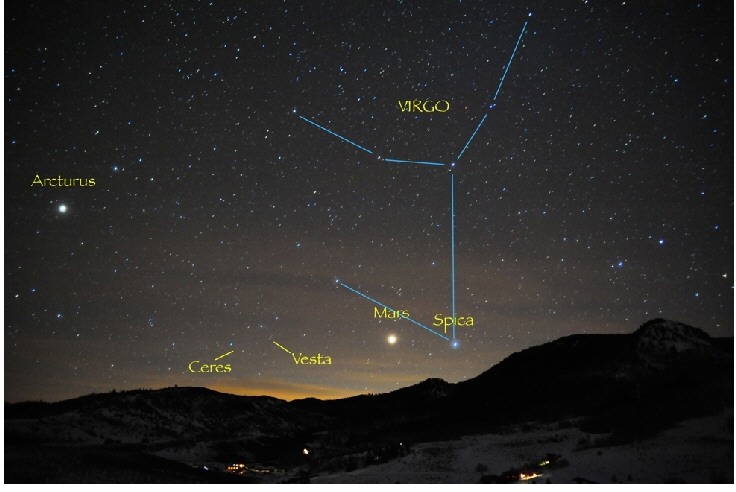
MARS
RED MARS, BLUE SPICA, BIG ASTEROIDS: Mars is approaching Earth for a close encounter in mid-April. As the two planets converge, the red color of Mars is becoming increasingly vivid to the naked eye. This is especially true because Mars is located not far from Spica, a blue-giant star of first magnitude in the constellation Virgo. Each evening when Mars and Spica rise side by side in the eastern sky, the red-blue contrast is eye-catching:
Astronomy professor Jimmy Westlake of Colorado Mountain College took the picture on March 20th, the first night of northern spring, and labeled it to show not only "ruddy Mars and icy-blue Spica," but also two nearby space rocks.
"This spring, Mars is looping through the stars of Virgo alongside the large asteroids Ceres and Vesta," explains Westlake. "All three reach opposition next month: Mars on April 8th, Vesta on April 13th, and Ceres on April 15th. Vesta, the nearer and more reflective of the two, appears about a magnitude brighter than Ceres. Both are within easy grasp of binoculars."
Look for Mars and Spica rising in the east after sunset, around 9 pm local time. A backyard telescope pointed at Mars will show you more than a red dot. Mars's north polar cap, surface features and clouds are being photographed by amateur astronomers around the world as the red planet grows larger in the eyepiece every night.
2 Fireballs reported
3-22-14
Solar wind
speed: 483.4 km/sec
density: 1.6 protons/cm3
2 Fireballs reported
3-21-14
Solar wind
speed: 339.2 km/sec
density: 5.7 protons/cm3
DOUBLE FLARE: Long ago researchers thought solar flares were isolated events.Magnetic fields above a single sunspot became unstable and exploded--end of story. The Solar Dynamics Observatory's global view of the sun has shown, however, that widely-separated sunspots can explode in tandem. That's what happened on March 20th when AR2010 and AR2014 combined for a double flare:
Transparent arcs of magnetism stretching across the 400,000 km divide between the two sunspots allow them to communicate magnetohydrodynamically, so instabilities in one can affect the other. This appears to be a textbook example of a 'sympathetic flare.' The most famous example occurred on August 1, 2010. SDO watched as instabilities jumped vast distances from one sunspot to another, setting off a chain reaction that engulfed more than half the sun. Compared to that global eruption, today's double flare was puny--or as puny as two explosions more powerful than a billion nuclear bombs can be.
5 Fireballs reported
3-20-14
Solar wind
speed: 333.5 km/sec
density: 3.2 protons/cm3
SOLAR 'SUPERSTORM' NARROWLY MISSES EARTH: The heliophysics communitty is buzzing today in response to an article in Nature Communications, which describes an intense solar storm that narrowly missed Earth almost two years ago. On July 23, 2012, a CME rocketed away from the sun at 2000 km/s, almost four times faster than a typical eruption. The storm tore through Earth orbit, but fortunately Earth wasn't there. Instead it hit the STEREO-A spacecraft, which experienced the most intense solar proton storm since 1976. Researchers have been analyzing the data ever since, and they have concluded that the storm was akin to the Carrington Event of 1859.
"Had it hit Earth, it probably would have been like the big one in 1859," says Janet Luhmann of UC Berkeley, a co-author of the paper. "The effect today [on] our modern technologies would have been tremendous."
The Carrington Event was a series of powerful CMEs that hit Earth head-on, sparking Northern Lights as far south as Tahiti. Intense geomagnetic storms caused global telegraph lines to spark, setting fire to some telegraph offices and disabling the 'Victorian Internet." A similar storm today would have a catastrophic effect on modern power grids and telecommunication networks. According to a study by the National Academy of Sciences, the total economic impact could exceed $2 trillion or 20 times greater than the costs of a Hurricane Katrina. Multi-ton transformers fried by such a storm could take years to repair.
The paper in Nature Communications describes what gave the July 2012 storm Carrington-like potency. For one thing, the CME was actually two CMEs separated by only 10 to 15 minutes. Plus the CMEs traveled through a region of space that had been cleared out by another CME four days earlier. As a result, they were not decelerated as much as usual by their transit through the interplanetary medium.
The storm clouds crossed Earth's orbit in a place where Earth itself would be about 1 week later, so it was a relatively narrow escape. The whole episode highlights the perils of space weather. Many observers have noted that the current solar cycle is weak, perhaps the weakest in 100 years. Now we see that even a weak solar cycle can produce a very strong storm. Earth is not safe from these kind of events, so it's time to be prepared.
The original research reported here may be found in Nature Communications: "Observations of an extreme storm in interplanetary space caused by successive coronal mass ejections" by Ying D. Liu et al., published on March, 18, 2014.
DOUBLE FLARE: Long ago researchers thought solar flares were isolated events. Magnetic fields above a single sunspot became unstable and exploded--end of story. The Solar Dynamics Observatory's global view of the sun has shown, however, that widely-separated sunspots can explode in tandem. That's what happened on March 20th when AR2010 and AR2014 combined for a double flare:
SPRING IS AURORA SEASON: The seasons are changing. Today, March 20th,the sun crossed the celestial equator heading north. This marks the beginning of spring in the northern hemisphere and autumn in the southern hemisphere. At this time of year, day and night are of nearly equal length--hence the name "equinox" (equal night). Moreover, spring is aurora season. Arctic sky watchers should be alert for Northern Lights in the nights ahead.
3-19-14
Solar wind
speed: 314.8 km/sec
density: 2.1 protons/cm3
NEW YORK BLACKOUT: On Thursday morning, March 20th, at 2:06 a.m. EDT, main belt asteroid 163 Erigone will eclipse the bright star Regulus over the New Yorkmetropolitan area. Weather permitting, observers can see the star wink out of sight for as much as 14 seconds. This is the first time in recorded history that an asteroid blacks out a naked-eye star in view of such a heavily populated area. Get the full story from Sky and Telescope.
MAGNETIC FILAMENTS: The biggest structures on the sun today are not sunspots. Dwarfing all of the ordinary active regions, a pair of dark magnetic filaments are stretching across the almost-entire circumference of the sun's southern hemisphere.
Containing masses of relatively cool plasma held suspended above the solar surface by magnetic forces, the sinuous structures are each more than 600,000 km long. If you put one end on Earth, the other would stretch far beyond the orbit of the Moon. Their dimensions make them easy targets for backyard solar telescopes.
Sometimes, magetic filaments such as these become unstable and collapse. This can lead to a Hyder flare--a type of explosion that does not require sunspots. Hyder flares this week would likely be Earth directed as the filaments are both facing our planet
3-18-14
Solar wind
speed: 339.3 km/sec
density: 4.3 protons/cm3
APPROACHING MARS: Count slowly: one one-thousand, two one-thousand, three one-thousand.... You're now 30 km closer to the planet Mars. Earth and Mars are converging for a close encounter in April 2014, an event astronomers call "opposition." At closest approach on April 14th, burnt-orange Mars will rise in the east at sunset and soar almost overhead at midnight shining 8 times brighter than a 1st magnitude star. Even now the view is impressive:
Romanian astrophotographer Maximilian Teodorescu took the picture on March 14th using an 11-inch Celestron telescope. "The Red Planet has a lot to offer," he says. "With the opposition getting closer every day, details are becoming more easily discernible." Teodorescu's images show a bank of icy clouds covering Hellas Basin, the widest and deepest impact crater on Mars. Also visible is the North Polar Cap, which is rapidly evaporating as summer unfolds in Mars' northern hemisphere.
Ready to see Mars for yourself? Tonight, March 18-19, the waning full Moon will pass by Mars in the constellation Virgo, making the Red Planet easy to locate. Point your optics at the bright burnt-orange "star" a few degrees above the lunar disk. Update: You're now about 600 km closer to Mars.
3-17-14
Solar wind
speed: 300.5 km/sec
density: 2.0 protons/cm3
ERUPTING FILAMENT CREATES A 'CANYON OF FIRE': For days, amateur astronomers have been monitoring two long, dark filaments of magnetism snaking around the sun's southeastern limb. On March 16th, one of them became unstable and erupted. The resulting explosion split the sun's atmosphere, creating a "canyon of fire," shown in a movie captured by the Solar Dynamics Observatory:
The glowing walls of the canyon are formed in a process closely related to that ofarcade loops, which appear after many solar flares. The structure traces the original channel where the filament was suspended by magnetic forces above the stellar surface.
As erupting magnetic filaments often do, this one launched a coronal mass ejection (CME) into space. Update: The Solar and Heliospheric Observatory recorded a movie of the cloud expanding at 800 km/s (1.8 million mph). NOAA analysts say the CME is traveling south of the sun-Earth line and should not be geoeffective.
6 fireballs reported.
3-16-14
Solar wind
speed: 318.7 km/sec
density: 1.4 protons/cm3
FULL WORM MOON: Tonight's full Moon has a special name--the Worm Moon. It signals the coming of northern spring, a thawing of the soil, and the first stirrings of earthworms in long-dormant gardens. Step outside tonight and behold the wakening landscape. "Worm moonlight" is prettier than it sounds. [photo gallery]
6 fireballs reported
3-15-14
Solar wind
speed: 392.7 km/sec
density: 2.0 protons/cm3
DARK FILAMENTS ON THE SUN: Amateur astronomers are noting an outbreak of dark magnetic filaments on the sun. The longest, which measure 100,000 km to 250,000 km from end to end, are snaking around the sun's southeastern limb. Sergio Castillo sends this picture from his backyard observatory in Inglewood, CA:
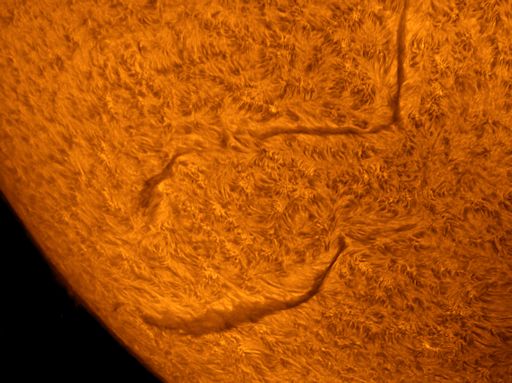
"If they collapse, these monster solar filaments could produce a Hyder flare," says Castillo. Indeed, he continues, "one of them erupted just yesterday."
With all of the sunspots on the Earthside of the sun currently quieting, these filaments could be the source of greatest solar activity this weekend. Amateur astronomers with solar telescopes are encouraged to monitor developments
SOLAR ECLIPSE: This morning there was a total eclipse of the sun. No one on Earth, however, experienced a blackout. You had to be in Earth orbit to see it. NASA's Solar Dynamics Observatory photographed the event at 06:24 UT
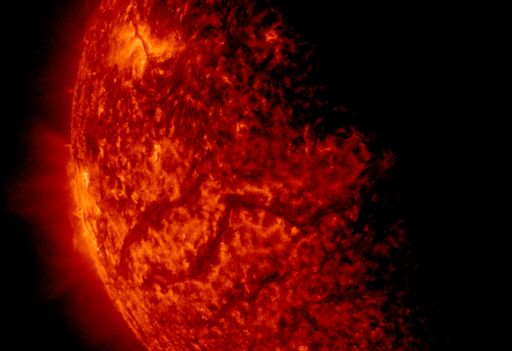
Earth itself passed directly in front of the spacecraft, eclipsing the sun. The image, above, shows about 50% coverage. A moment later, the entire sun was gone.
This is SDO's spring eclipse season. Twice every year, around the time of the equinoxes, Earth can pass directly between the Sun and NASA's Solar Dynamics Observatory. At the moment, SDO is near the midpoint of the season when the eclipses are longest and deepest. Once a day, Earth blocks the complete sun for more than an hour. That still allows almost 23 hours for monitoring solar activity, so not much action is missed. Eclipse season ends about a week from now.
6 fireballs reported
3-14-14
Solar wind
speed: 412.8 km/sec
density: 2.1 protons/cm3
HAPPY PI DAY: Today,
March 14th (3.14), is ![]() day,
and all around the world pi-philes are celebrating one
of the most compelling and mysterious constants of Nature. Pi appears
in equations describing the orbits of planets, the colors of auroras, the
structure of DNA. The value of
day,
and all around the world pi-philes are celebrating one
of the most compelling and mysterious constants of Nature. Pi appears
in equations describing the orbits of planets, the colors of auroras, the
structure of DNA. The value of ![]() is
woven into the fabric of life, the universe and ... everything.
is
woven into the fabric of life, the universe and ... everything.
Humans have struggled to
calculate ![]() for
thousands of years. Divide the circumference of a circle by its diameter; the
ratio is
for
thousands of years. Divide the circumference of a circle by its diameter; the
ratio is ![]() .
Sounds simple, but the devil is in the digits. While the value of
.
Sounds simple, but the devil is in the digits. While the value of ![]() is
finite (a smidgen more than 3), the decimal number is infinitely long:
is
finite (a smidgen more than 3), the decimal number is infinitely long:
3.1415926535897932384626433832795
02884197169399375105820974944592307
81640628620899862803482534211706...more
Supercomputers have succeeded in calculating more than 2700 billion digits
and they're still crunching. The weirdest way to compute ![]() :
throw needles at
a table orfrozen
hot dogs on the floor. Party
time.
:
throw needles at
a table orfrozen
hot dogs on the floor. Party
time.
ERUPTING MAGNETIC FILAMENT: This morning, a filament of magnetism located just behind the sun's southeastern limb rose up and erupted. NASA's Solar Dynamics Observatory photographed a massive loop of plasma flying over the blast site:
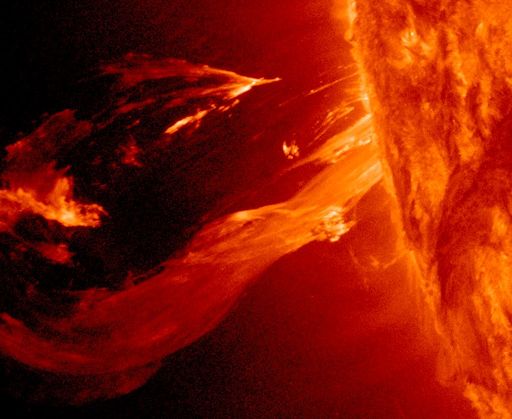
For scale, the planet Neptune could slide through the loop with room to spare. Earth could fit inside more than 4 times over.
As the erupting filament flew threw the sun's atmosphere, it propelled a coronal mass ejection (CME) into space with pieces of the filament itself at its core. The Solar and Heliospheric Observatory (SOHO) tracked the CME as it raced away from the sun: movie. Earth was not in the line of fire
7 fireballs reported
3-13-14
Solar wind
speed: 456.2 km/sec
density: 4.2 protons/cm3
ALMOST-X FLARE: Departing sunspot AR1996 erupted on March 12th at 2234 UT, producing an M9-category blast that almost crossed into X-territory. NASA's Solar Dynamics Observatory captured the extreme ultra-violet flash:
UV radiation from the flare caused waves of ionization to ripple through Earth's upper atmosphere. These waves briefly altered the propagation of low-frequency radio transmisions around the planet, as shown in this plot from amateur radio astronomer Jim Tegerdine of Marysville, Washington. Otherwise the flare was not geoeffective. The sunspot's location near the sun's eastern limb mitigated Earth effects.
The next big flare could have a greater influence on our planet. Sunspot AR2002 is directly facing Earth, and it has a 'beta-gamma-delta' magnetic field that harbors energy for strong explosions. NOAA forecasters estimate an 80% chance of M-class flares and a 15% chance of X-flares on March 13th
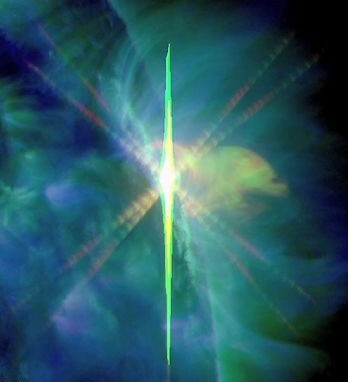
AURORA SURPRISE: Observers around the Arctic Circle were surprised last night when the skies overhead erupted in swirls of verdant color. Rayann Elzein sends this picture from Inari in the Finnish Lapland:
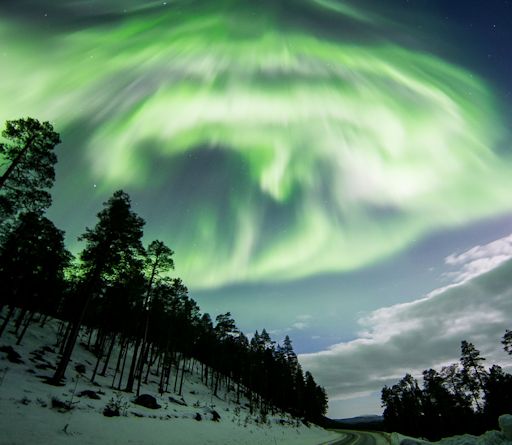
"Although there was no forecast of strong activity, auroras were dancing high in the sky--very bright and very fast," says Elzein. "They were the most breathtaking auroras that I have ever seen up here in Lapland!"
The unexpected storm, a relatively minor G1-class event, was caused by a fluctuation in the interplanetary magnetic field (IMF). As March 12th turned to 13th, the IMF tilted south, opening a crack in Earth's magnetosphere. Solar wind poured in and fueled the display.
8 fireballs reported
3-12-14
Solar wind
speed: 321.2 km/sec
density: 11.0 protons/cm3
CHANCE OF FLARES: Sunspot AR2002 has been mostly quiet for the past 24 hours. Nevertheless, the Earth-facing active region has a'beta-gamma-delta' magnetic field that harbors energy for strong eruptions. NOAA forecasters estimate a 75% chance of M-class flares and a 15% chance of X-class flares on March 12th.
3 fireballs reported
3-11-14
Solar wind
speed: 324.2 km/sec
density: 1.3 protons/cm3
GROWING CHANCE OF FLARES: Sunspot AR2002 poses a growing threat for solar flares. Since the week began, the active region has more than tripled in size. It now has more than a dozen dark cores and sprawls across 100,000 km of solar terrain. Karzaman Ahmad sends this picture, taken just hours ago, from the Langkawi National Observatory in Malaysia:
"AR2002 is so large," says Ahmad, "that I was able to photograph it using an ordinary 11-inch Celestron telescope capped with a Thousand Oaks Glass Filter." The exceptionally crisp image shows thousands of boiling granules surrounding the sunspot's dark cores. Each granule is about the size of Texas
3 FIREBALLS REPORTED
3-10-14
Solar wind
speed: 339.6 km/sec
density: 2.3 protons/cm3
CONTINUED CHANCE OF MINOR STORMS: NOAA forecasters estimate a 30% chance of minor geomagnetic storms on March 9th when a solar wind stream is expected to brush against Earth's magnetic field. High-latitude sky watchers should be alert for auroras. The best time to look is during the hours around local midnight
9 fireballs reported
There was a 6.9 earthquake 50 miles off the coast of Eureka, CA. No reported damage or injuries related to the quake and no loss of power. It was a rolling quake that lasted about 20 seconds. The animals didn't like it and panicked, but the people didn't even flinch because the rolling was so gentle, like in a gently lolling boat on the sea.
3-9-14
Solar wind
speed: 350.2 km/sec
density: 2.4 protons/cm3
CONTINUED CHANCE OF MINOR STORMS: NOAA forecasters estimate a 30% chance of minor geomagnetic storms on March 9th when a solar wind stream is expected to brush against Earth's magnetic field. High-latitude sky watchers should be alert for auroras. The best time to look is during the hours around local midnight.Aurora alerts: text, voice
9 fireballs reported
3-8-14
Solar wind
speed: 409.5 km/sec
density: 0.5 protons/cm3
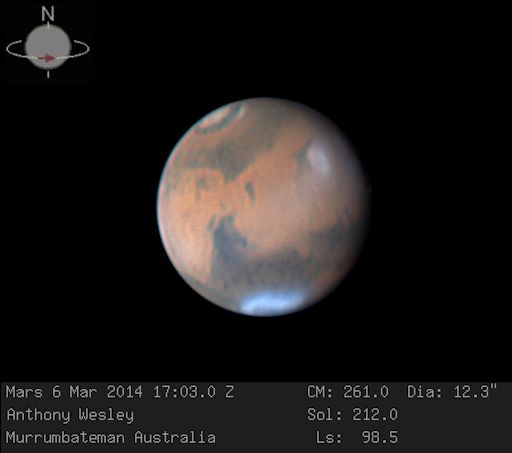
STORM CLOUDS ON MARS: Next month, Earth and Mars will converge for their closest approach of 2014. Opposition occurs on April 8th. That's when Mars rises in the east at sunset, almost perfectly opposite the sun, and soars overhead at midnight shining 8 times brighter than a 1st-magnitude star. Although closest approach is still weeks away away, astronomers are already enjoying great views of the Red Planet. Australian astrophotographer Anthony Wesley took this picture using a 16-inch telescope on March 6th:
His high-resolution image shows orographic clouds over the Elysium volcanoes just north of the Martian equator and an even brighter blue cloud over the Hellas impact basin in the southern hemisphere. Hellas is the lowest point on Mars, and some of the haze evident there could be icy fog.
Getting such Hubblesque results from a 16-inch telescope requires a combination of good seeing and long years of experience. Wesley, who is one of the world's top amateur astrophotographers, had both working for him on the morning of March 6th. "Skies were stable and clear," he says. "Using a Point Grey Research low-light Grasshopper3 camera, I recorded 2 minutes through red, green and blue filters with red @ 83fps, green@70fps and blue @50fps. I sorted all the frames according to image sharpness and stacked the best 2000 in each channel to make the color image, with additional wavelet sharpening in Registax, deconvolution in Astra Image and final color correction and touchups+captioning in the GIMP."
Observers with less experience can take good photos, too, especially as March gives way to April and Mars approaches Earth. Look for burnt-orange Mars rising in the east around around 10 p.m. about 5° from the blue 1st-magnitude star Spica. The Moon passes by Mars on March 19-20 and provides a convenient "landmark" for finding the Red Planet. For more information about what you can expect to see on Mars, click here.
6 fireballs reported
3-7-14
Solar wind
speed: 434.4 km/sec
density: 1.0 protons/cm3
CORONAL HOLE: In the sun's northern hemisphere, magnetic fields have opened up, allowing a stream of solar wind to escape into space. Such openings are called "coronal holes". NASA's Solar Dynamics Observatory took this picture of the structure during the early hours of March 6th:
A stream of solar wind flowing from this coronal hole should reach Earth on or about March 9th. Because the "spigot" is located in the sun's northern hemisphere, the stream will sail mostly north of our planet, delivering only a glancing blow to Earth's magnetic field.
A glancing blow, however, might be enough to spark polar auroras. For reasons that researchers don't fully understand, spring is aurora season. With the northern vernal equinox just around the corner, even small gusts of solar wind can stir up geomagnetic activity. Stay tuned for auroras. Aurora alerts: text, voice
6 FIREBALLS REPORTED YESTERDAY
3-6-14
ASTEROID EE14 DUE TO COME PAST THIS DATE
ASTEROID FLYBY: Today, asteroid 2014 DX110 will fly past Earth just inside the orbit of the Moon. There is no danger of a collision with the 30-meter space rock. At closest approach it will be approximately 350,000 km from our planet. [3D orbit] [photos: #1, #2]
3-5-14
Solar wind
speed: 453.1 km/sec
density: 2.3 protons/cm3
Dual coronagraph images from SOHO (stationed on the Earthside of the sun) and the STEREO-A probe (stationed on the farside) clearly show that this CME is a farside event. Radio emissions from shock waves at the leading edge of the blast suggest the cloud is racing away from Earth at approximately 1400 km/s (3 million mph). If it were racing in the opposite direction, we would have a significant geomagnetic storm in the offing. Instead, space weather around Earth is expected to remain calm for the rest of this week.
63-4-14
Solar wind
speed: 369.7 km/sec
density: 4.6 protons/cm3
AURORA ROCKET LAUNCHED: On the night of March 3rd, with green lights swirling overhead, scientists at the University of Alaska's Poker Flat Research Range launched a 48-foot sounding rocket directly into the aurora borealis. "For weeks we've been sitting out all night every night, and though we've seen many good aurora, we haven't seen the type we wanted, in the position we wanted - until now," says graduate student Jason Ahrns, who sends this picture of the rocket in flight: The rocket launch was part of a NASA-sponsored campaign called GREECE---short for "Ground-to-Rocket Electrodynamics-Electrons Correlative Experiment." Marilia Samara, a space scientist at the Southwest Research Institute in San Antonio, Texas, is the principal investigator. GREECE aims to solve a long-standing mystery about auroras: Often, when a display begins, the lights are placid and widely spread across thousands of kilometers. Then, for reasons no one fully understands, the auroras will break up into highly-structured and rapidly changing arcs, swirls, curls, pillars, even "flames," with changes occurring on fraction-of-a-second time scales. Sensors on the Data from the sounding rocket will help researchers unravel the electrodynamics underlying these sudden and unpredictable transitions. "Preliminary expectations are that the launch was a total and complete success with lots of good science to come out of it," reports Ahrns. Check the GREECE blog for updates. Aurora alerts: text, voiceRealtime Aurora Photo Gallery BLUE AURORAS: Northern Lights are usually green, and sometimes red. Those are the colors produced by oxygen when it is excited by electrons raining down from space. On Feb. 22nd, Micha Bäuml of Straumfjord, Norway, witnessed an appariton of aurora-blue
"All of a sudden the sky exploded," says Micha. "The aurora looked like a giant flame." In auroras, blue is a sign of nitrogen. Energetic particles striking ionized molecular nitrogen (N2+) at very high altitudes produces a cold azure glow of the type captured in Micha's photo. Why it overwhelmed the usual hues of oxygen on Feb 22nd is unknown. Auroras still have the capacity to surprise. Any auroras tonight, blue or otherwise, will be a bit of a surprise. Geomagnetic conditions are quiet. NOAA forecasters estimate a scant 5% chance of polar geomagnetic storms on March 3rd 1 fireball reported |
3-3-14
Solar wind
speed: 347.7 km/sec
density: 5.3 protons/cm3
0 fireballs reported
3-2-14
Solar wind
speed: 365.4 km/sec
density: 4.0 protons/cm3
GROWING CHANCE OF FLARES: The face of the sun is peppered with spots. One of them in particular merits attention. AR1991 is rapidly growing, almost doubling its number of dark cores since yesterday.
AR1991 has a 'beta-gamma' magnetic field that harbors energy for M-class solar flares. The rapid evolution of the sunspot could destabilize the field, making an eruption more likely. NOAA forecasters estimate a 70% chance of M-class flares and a 30% chance of X-flares on March 2nd. Solar flare alerts: text, voice
The region has grown so large -- it spans more than 150,000 km of solar terrain -- that observers are starting to notice it without the aid of a solar telescope. "This morning in Singapore, clouds acted as a natural filter.
6 fireballs reported on 3-1-14
3-1-14
Solar wind
speed: 380.6 km/sec
density: 2.9 protons/cm3

THE AFTERGLOW: Earth's polar magnetic field is still alight with auroras following the CME impact of Feb. 27th. The strongest displays have faded, but the afterglow is beautiful, too:
Harald Albrigtsen took the picture on March 1st from Kvaløya island in Tromsø, Norway. Onlooker Anne Birgitte Fyhn describes the scene: "After a cloudy evening the sky started turning clear after midnight. We watched these quiet, green auroras above some fish-racks at a local beach."
NOAA forecasters estimate a 25% chance of more geomagnetic storms on March 1-2 as CME effects subside. Arctic sky watchers, enjoy the afterglow! Aurora alerts: text, voice
6 fireballs reported 3-1-14
| Asteroid |
Date(UT)
|
Miss Distance
|
Size
|
| 2014 DK10 |
Feb 21
|
0.7 LD
|
12 m
|
| 2014 DH6 |
Feb 23
|
2 LD
|
30 m
|
| 2014 CR |
Feb 24
|
8.3 LD
|
124 m
|
| 2000 EE14 |
Mar 6
|
64.6 LD
|
1.8 km
|
| 2014 CU13 |
Mar 11
|
8 LD
|
190 m
|
| 2014 DU22 |
Mar 14
|
7.7 LD
|
51 m
|
| 2003 QQ47 |
Mar 26
|
49.9 LD
|
1.4 km
|
| 1995 SA |
Apr 2
|
73.1 LD
|
1.6 km
|
| 2000 HD24 |
Apr 4
|
42.2 LD
|
1.3 km
|
| 2007 HB15 |
Apr 28
|
6.7 LD
|
12 m
|